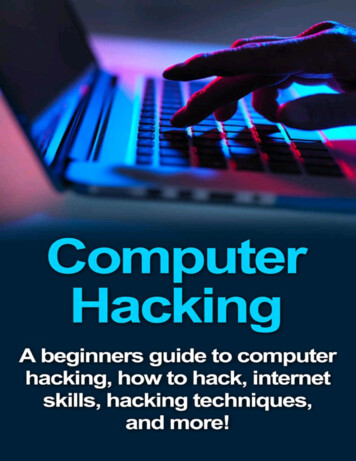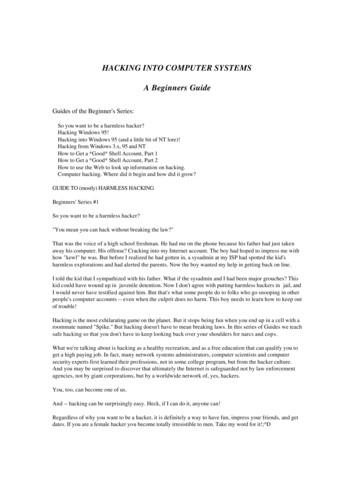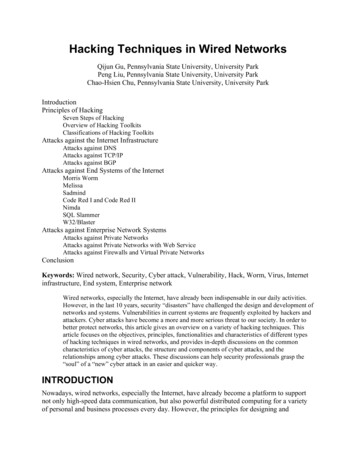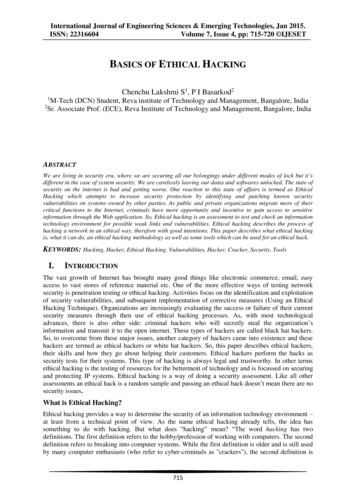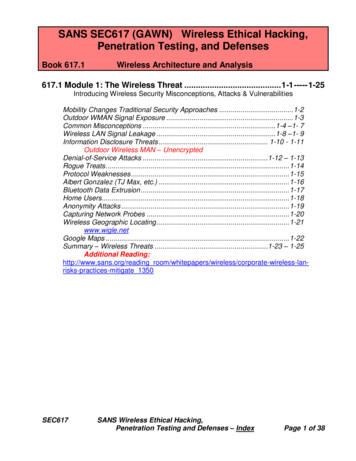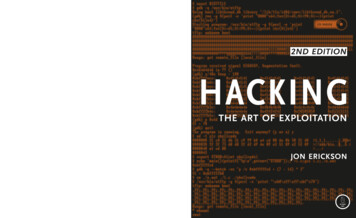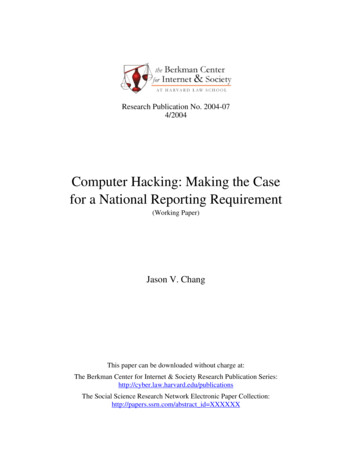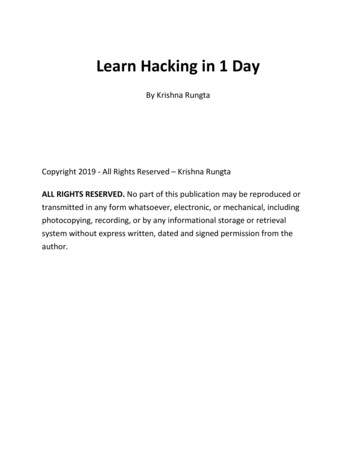
Transcription
Learn Hacking in 1 DayBy Krishna RungtaCopyright 2019 - All Rights Reserved – Krishna RungtaALL RIGHTS RESERVED. No part of this publication may be reproduced ortransmitted in any form whatsoever, electronic, or mechanical, includingphotocopying, recording, or by any informational storage or retrievalsystem without express written, dated and signed permission from theauthor.
Table Of ContentChapter 1: What is Hacking? Introduction & Types1.2.3.4.5.6.7.What is Hacking?Types of HackersWhat is Cybercrime?Type of CybercrimeWhat is Ethical Hacking?Why Ethical Hacking?Legality of Ethical HackingChapter 2: Potential Security Threats To Your Computer Systems1. What is a Security Threat?2. What are Physical Threats?3. What are Non-physical threats?Chapter 3: Skills Required to Become a Ethical Hacker1.2.3.4.5.What is a programming language?Why should you learn how to program?What languages should I learn?Programming languages that are useful to hackersOther skillsChapter 4: What is Social Engineering? Attacks, Techniques & Prevention
1.2.3.4.What is Social Engineering?How social engineering Works?Common Social Engineering TechniquesSocial Engineering Counter MeasuresChapter 5: Cryptography Tutorial: Cryptanalysis, RC4, CrypTool1.2.3.4.5.6.7.What is Cryptography?What is Cryptanalysis?What is cryptology?Encryption AlgorithmsHacking Activity: Use CrypToolCreating the RC4 stream cipherAttacking the stream cipherChapter 6: How to Crack a Password1.2.3.4.5.6.7.What is Password Cracking?What is password strength?Password cracking techniquesPassword cracking toolPassword Cracking Counter MeasuresHacking Activity: Hack Now!Password cracking stepsChapter 7: Worm, Virus & Trojan Horse: Ethical Hacking Tutorial1. What is a Trojan horse?2. What is a worm?
3. What is a Virus?4. Trojans, Viruses, and Worms counter measures5. Trojan, Virus, and Worm Differential TableChapter 8: Learn ARP Poisoning with Examples1.2.3.4.What is IP and MAC AddressesExerciseWhat is ARP Poisoning?Hacking Activity: Configure ARP entries in WindowsChapter 9: Wireshark Tutorial: Network & Passwords Sniffer1.2.3.4.5.6.7.What is network sniffing?Passive and Active SniffingHacking Activity: Sniff network trafficSniffing the network using WiresharkWhat is a MAC Flooding?Counter Measures against MAC floodingSniffing Counter MeasuresChapter 10: How to Hack WiFi (Wireless) Network1.2.3.4.5.6.7.What is a wireless network?How to access a wireless network?Wireless Network AuthenticationWEPWPAHow to Crack Wireless NetworksWEP Cracking Tools
8.9.10.11.12.WPA CrackingGeneral Attack typesCracking Wireless network WEP/WPA keysHow to Secure wireless networksHacking Activity: Crack Wireless PasswordChapter 11: DoS (Denial of Service) Attack Tutorial: Ping of Death, DDOS1.2.3.4.5.6.7.What is DoS Attack?Types of Dos AttacksHow DoS attacks workDoS attack toolsDoS Protection: Prevent an attackHacking Activity: Ping of DeathHacking Activity: Launch a DOS attackChapter 12: How to Hack a Web Server1.2.3.4.5.6.7.Web server vulnerabilitiesTypes of Web ServersTypes of Attacks against Web ServersEffects of successful attacksWeb server attack toolsHow to avoid attacks on Web serverHacking Activity: Hack a WebServerChapter 13: How to Hack a Website: Online Example1. What is a web application? What are Web Threats?2. How to protect your Website against hacks?
3. Hacking Activity: Hack a Website4. Session Impersonation using Firefox and Tamper Data add-onChapter 14: SQL Injection Tutorial: Learn with Example1.2.3.4.5.6.7.What is a SQL Injection?How SQL Injection WorksHacking Activity: SQL Inject a Web ApplicationOther SQL Injection attack typesAutomation Tools for SQL InjectionHow to Prevent against SQL Injection AttacksHacking Activity: Use Havij for SQL InjectionChapter 15: Hacking Linux OS: Complete Tutorial with Ubuntu Example1.2.3.4.Quick Note on LinuxLinux Hacking ToolsHow to prevent Linux hacksHacking Activity: Hack a Ubuntu Linux System using PHPChapter 16: CISSP Certification Guide: What is, Prerequisites, Cost, CISSPSalary1.2.3.4.5.6.7.What is CISSP?Important Domain of CISSP CertificateSkills developed after CISSP certificationWho should do a CISSP certification?How to become CISSP certified?Why become CISSP Certified?Course Objectives of CISSP Certification
8. Guide to ace CISSP certification9. Salary of CISSP certified professional.Chapter 17: 10 Most Common Web Security Vulnerabilities1.2.3.4.5.6.7.8.9.10.SQL InjectionCross Site ScriptingBroken Authentication and Session ManagementInsecure Direct Object ReferencesCross Site Request ForgerySecurity MisconfigurationInsecure Cryptographic StorageFailure to restrict URL AccessInsufficient Transport Layer ProtectionUnvalidated Redirects and ForwardsChapter 18: Kali Linux Tutorial: What is, Install, Utilize Metasploit and Nmap1.2.3.4.5.6.7.8.What is Kali Linux?Who uses Kali Linux and Why?Kali Linux Installation MethodsInstall Kali Linux using Virtual BoxGetting Started with Kali Linux GUIWhat is Nmap?How to Perform a Basic Nmap Scan on Kali LinuxWhat is Metasploit?
Chapter 1: What is Hacking?Introduction & TypesWhat is Hacking?Hacking is identifying weakness in computer systems or networks toexploit its weaknesses to gain access. Example of Hacking: Using passwordcracking algorithm to gain access to a systemComputers have become mandatory to run a successful businesses. It is notenough to have isolated computers systems; they need to be networked tofacilitate communication with external businesses. This exposes them to theoutside world and hacking. Hacking means using computers to commitfraudulent acts such as fraud, privacy invasion, stealing corporate/personaldata, etc. Cyber crimes cost many organizations millions of dollars everyyear. Businesses need to protect themselves against such attacks.Before we go any further, let’s look at some of the most commonly usedterminologies in the world of hacking.Who is a Hacker? Types of HackersA Hacker is a person who finds and exploits the weakness in computersystems and/or networks to gain access. Hackers are usually skilledcomputer programmers with knowledge of computer security.
Hackers are classified according to the intent of their actions. The followinglist classifies hackers according to their intent.SymbolDescriptionEthical Hacker (White hat): A hacker whogains access to systems with a view to fixthe identified weaknesses. They may alsoperform penetration Testing andvulnerability assessments.Cracker (Black hat): A hacker who gainsunauthorized access to computer systemsfor personal gain. The intent is usually tosteal corporate data, violate privacy rights,transfer funds from bank accounts etc.Grey hat: A hacker who is in betweenethical and black hat hackers. He/shebreaks into computer systems withoutauthority with a view to identifyweaknesses and reveal them to the systemowner.
Script kiddies: A non-skilled personwho gains access to computersystems using already made tools.Hacktivist: A hacker who use hackingto send social, religious, and political,etc. messages. This is usually done byhijacking websites and leaving themessage on the hijacked website.Phreaker: A hacker who identifiesand exploits weaknesses intelephones instead of computers.
What is Cybercrime?Cyber crime is the use of computers and networks to perform illegalactivities such as spreading computer viruses, online bullying, performingunauthorized electronic fund transfers, etc. Most cybercrimes arecommitted through the internet. Some cybercrimes can also be carried outusing Mobile phones via SMS and online chatting applications.Type of CybercrimeThe following list presents the common types of cybercrimes:Computer Fraud: Intentional deception for personal gain via the use ofcomputer systems.Privacy violation: Exposing personal information such as emailaddresses, phone number, account details, etc. on social media,websites, etc.Identity Theft: Stealing personal information from somebody andimpersonating that person.Sharing copyrighted files/information: This involves distributingcopyright protected files such as eBooks and computer programs etc.
Electronic funds transfer: This involves gaining an un- authorized accessto bank computer networks and making illegal fund transfers.Electronic money laundering: This involves the use of the computer tolaunder money.ATM Fraud: This involves intercepting ATM card details such as accountnumber and PIN numbers. These details are then used to withdrawfunds from the intercepted accounts.Denial of Service Attacks: This involves the use of computers inmultiple locations to attack servers with a view of shutting them down.Spam: Sending unauthorized emails. These emails usually containadvertisements.What is Ethical Hacking?Ethical Hacking is identifying weakness in computer systems and/orcomputer networks and coming with countermeasures that protect theweaknesses. Ethical hackers must abide by the following rules.Get written permission from the owner of the computer systemand/or computer network before hacking.Protect the privacy of the organization been hacked. Transparentlyreport all the identified weaknesses in the computer system to theorganization.Inform hardware and software vendors of the identified weaknesses.Why Ethical Hacking?
Information is one of the most valuable assets of an organization.Keeping information secure can protect an organization’s image andsave an organization a lot of money.Hacking can lead to loss of business for organizations that deal infinance such as PayPal. Ethical hacking puts them a step ahead of thecyber criminals who would otherwise lead to loss of business.Legality of Ethical HackingEthical Hacking is legal if the hacker abides by the rules stipulated in theabove section on the definition of ethical hacking. The International Councilof E-Commerce Consultants (EC- Council) provides a certification programthat tests individual’s skills. Those who pass the examination are awardedwith certificates. The certificates are supposed to be renewed after sometime.SummaryHacking is identifying and exploiting weaknesses in computer systemsand/or computer networks.Cybercrime is committing a crime with the aid of computers andinformation technology infrastructure.Ethical Hacking is about improving the security of computer systemsand/or computer networks.Ethical Hacking is legal.
Chapter 2: Potential Security ThreatsTo Your Computer SystemsA computer system threat is anything that leads to loss or corruption ofdata or physical damage to the hardware and/or infrastructure. Knowinghow to identify computer security threats is the first step in protectingcomputer systems. The threats could be intentional, accidental or causedby natural disasters.In this article, we will introduce you to the common computer system threatsand how you can protect systems against them.What is a Security Threat?Security Threat is defined as a risk that which can potentially harmcomputer systems and organization. The cause could be physical such assomeone stealing a computer that contains vital data. The cause could alsobe non-physical such as a virus attack. In these tutorial series, we will definea threat as a potential attack from a hacker that can allow them to gainunauthorized access to a computer system.
What are Physical Threats?A physical threat is a potential cause of an incident that may result in lossor physical damage to the computer systems.The following list classifies the physical threats into three (3) main categories;Internal: The threats include fire, unstable power supply, humidity in therooms housing the hardware, etc.External: These threats include Lightning, floods, earthquakes, etc.Human: These threats include theft, vandalism of the infrastructureand/or hardware, disruption, accidental or intentional errors.
To protect computer systems from the above mentioned physical threats, anorganization must have physical security control measures.The following list shows some of the possible measures that can be taken:Internal: Fire threats could be prevented by the use of automatic firedetectors and extinguishers that do not use water to put out a fire. Theunstable power supply can be prevented by the use of voltagecontrollers. An air conditioner can be used to control the humidity in thecomputer room.External: Lightning protection systems can be used to protect computersystems against such attacks. Lightning protection systems are not 100%perfect, but to a certain extent, they reduce the chances of Lightningcausing damage. Housing computer systems in high lands are one of thepossible ways of protecting systems against floods.Humans: Threats such as theft can be prevented by use of locked doorsand restricted access to computer rooms.What are Non-physical threats?A non-physical threat is a potential cause of an incident that may result in;Loss or corruption of system dataDisrupt business operations that rely on computer systems Loss ofsensitive informationIllegal monitoring of activities on computer systems CyberSecurity BreachesOthers
The non-physical threats are also known as logical threats. The following listis the common types of non-physical threats;VirusTrojansWormsSpywareKey loggersAdwareDenial of Service Attacks DistributedDenial of Service AttacksUnauthorized access to computer systems resources such as dataPhishingOther Computer Security RisksTo protect computer systems from the above-mentioned threats, anorganization must have logical security measures in place. The following listshows some of the possible measures that can be taken to protect cybersecurity threatsTo protect against viruses, Trojans, worms, etc. an organization can useanti-virus software. In additional to the anti-virus software, an organizationcan also have control measures on the usage of external storage devices andvisiting the website that is most likely to download unauthorized programsonto the user’s computer.Unauthorized access to computer system resources can be prevented bythe use of authentication methods. The authentication methods can be, inthe form of user ids and strong passwords, smart cards or biometric, etc.
Intrusion-detection/prevention systems can be used to protect againstdenial of service attacks.There are other measures too that can be put inplace to avoid denial of service attacks.SummaryA threat is any activity that can lead to data loss/corruption through todisruption of normal business operations.There are physical and non-physical threatsPhysical threats cause damage to computer systems hardware andinfrastructure. Examples include theft, vandalism through to naturaldisasters.Non-physical threats target the software and data on the computersystems.
3. Hacking Activity: SQL Inject a Web Application 4. Other SQL Injection attack types 5. Automation Tools for SQL Injection 6. How to Prevent against SQL Injection Attacks 7. Hacking Activity: Use Havij for SQL Injection Chapter 15: Hacking Linux OS: Complete Tutorial with Ubuntu Example 1. Quick Note on Linux 2. Linux Hacking Tools 3.
